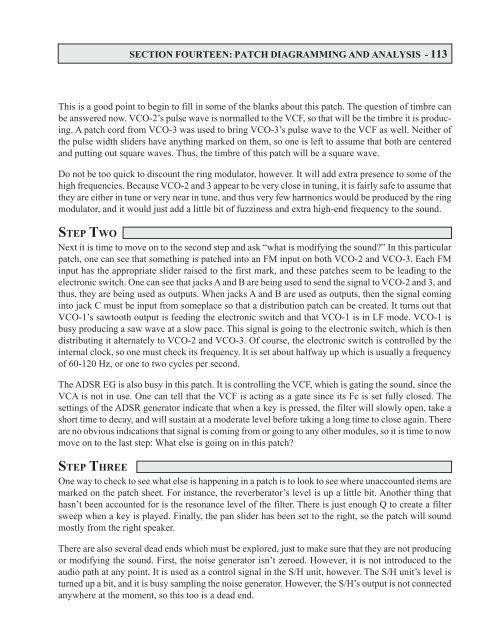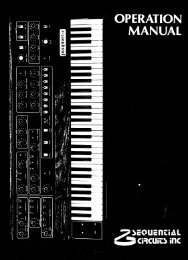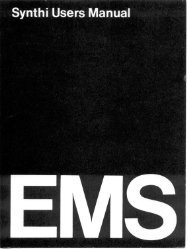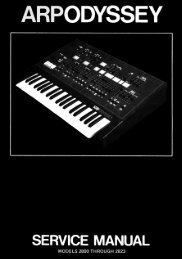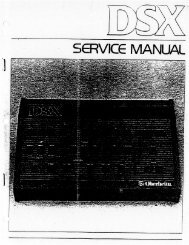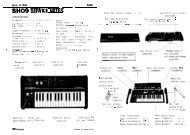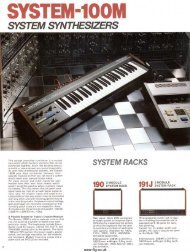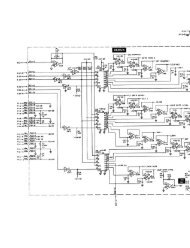ARP2600 - Fundamentals of Music Technology - Cyborgstudio.com
ARP2600 - Fundamentals of Music Technology - Cyborgstudio.com
ARP2600 - Fundamentals of Music Technology - Cyborgstudio.com
You also want an ePaper? Increase the reach of your titles
YUMPU automatically turns print PDFs into web optimized ePapers that Google loves.
SECTION FOURTEEN: PATCH DIAGRAMMING AND ANALYSIS - 113This is a good point to begin to fill in some <strong>of</strong> the blanks about this patch. The question <strong>of</strong> timbre canbe answered now. VCO-2’s pulse wave is normalled to the VCF, so that will be the timbre it is producing.A patch cord from VCO-3 was used to bring VCO-3’s pulse wave to the VCF as well. Neither <strong>of</strong>the pulse width sliders have anything marked on them, so one is left to assume that both are centeredand putting out square waves. Thus, the timbre <strong>of</strong> this patch will be a square wave.Do not be too quick to discount the ring modulator, however. It will add extra presence to some <strong>of</strong> thehigh frequencies. Because VCO-2 and 3 appear to be very close in tuning, it is fairly safe to assume thatthey are either in tune or very near in tune, and thus very few harmonics would be produced by the ringmodulator, and it would just add a little bit <strong>of</strong> fuzziness and extra high-end frequency to the sound.STEP TWONext it is time to move on to the second step and ask “what is modifying the sound?” In this particularpatch, one can see that something is patched into an FM input on both VCO-2 and VCO-3. Each FMinput has the appropriate slider raised to the first mark, and these patches seem to be leading to theelectronic switch. One can see that jacks A and B are being used to send the signal to VCO-2 and 3, andthus, they are being used as outputs. When jacks A and B are used as outputs, then the signal <strong>com</strong>inginto jack C must be input from someplace so that a distribution patch can be created. It turns out thatVCO-1’s sawtooth output is feeding the electronic switch and that VCO-1 is in LF mode. VCO-1 isbusy producing a saw wave at a slow pace. This signal is going to the electronic switch, which is thendistributing it alternately to VCO-2 and VCO-3. Of course, the electronic switch is controlled by theinternal clock, so one must check its frequency. It is set about halfway up which is usually a frequency<strong>of</strong> 60-120 Hz, or one to two cycles per second.The ADSR EG is also busy in this patch. It is controlling the VCF, which is gating the sound, since theVCA is not in use. One can tell that the VCF is acting as a gate since its Fc is set fully closed. Thesettings <strong>of</strong> the ADSR generator indicate that when a key is pressed, the filter will slowly open, take ashort time to decay, and will sustain at a moderate level before taking a long time to close again. Thereare no obvious indications that signal is <strong>com</strong>ing from or going to any other modules, so it is time to nowmove on to the last step: What else is going on in this patch?STEP THREEOne way to check to see what else is happening in a patch is to look to see where unaccounted items aremarked on the patch sheet. For instance, the reverberator’s level is up a little bit. Another thing thathasn’t been accounted for is the resonance level <strong>of</strong> the filter. There is just enough Q to create a filtersweep when a key is played. Finally, the pan slider has been set to the right, so the patch will soundmostly from the right speaker.There are also several dead ends which must be explored, just to make sure that they are not producingor modifying the sound. First, the noise generator isn’t zeroed. However, it is not introduced to theaudio path at any point. It is used as a control signal in the S/H unit, however. The S/H unit’s level isturned up a bit, and it is busy sampling the noise generator. However, the S/H’s output is not connectedanywhere at the moment, so this too is a dead end.


